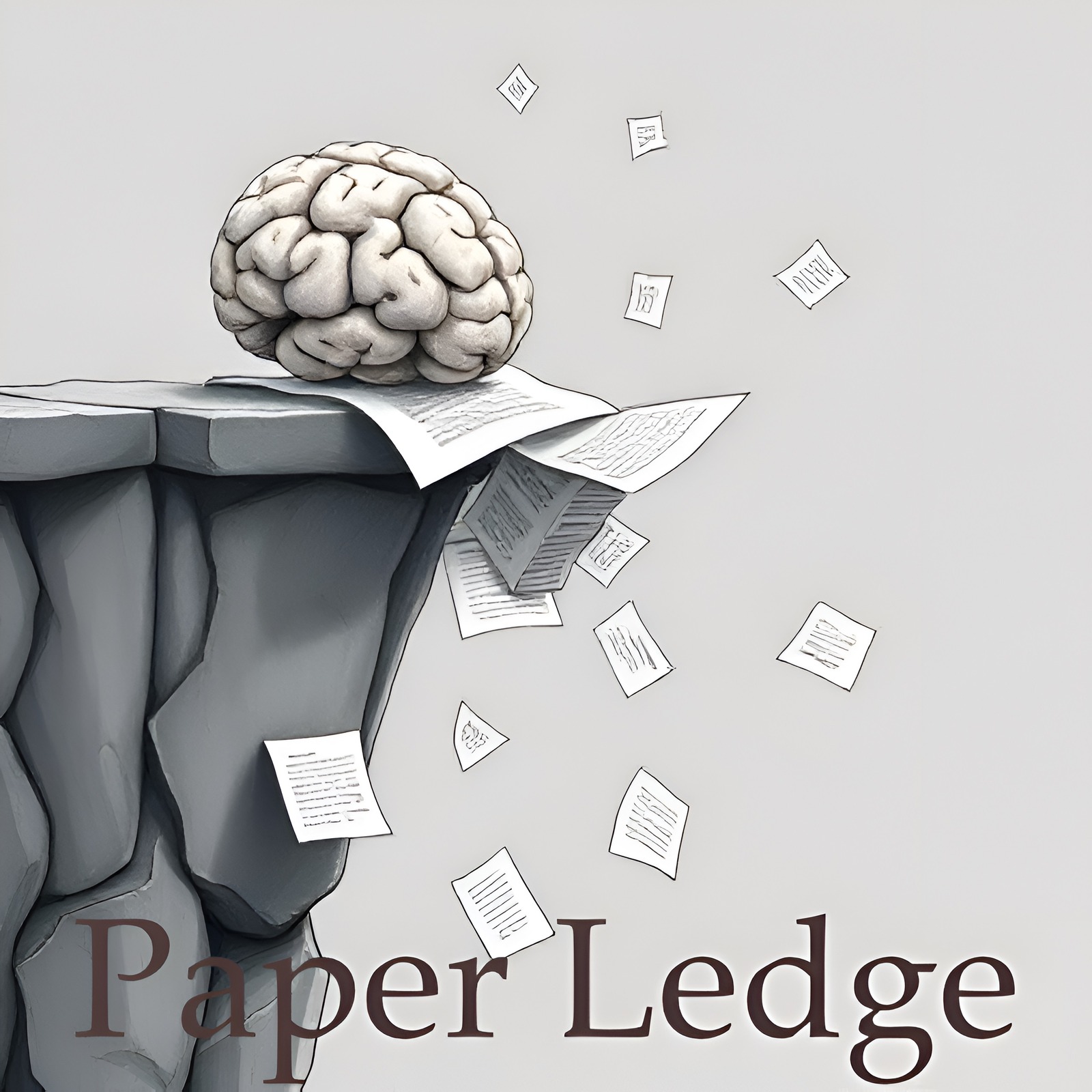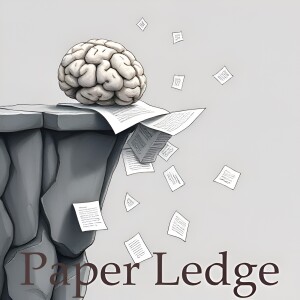PaperLedge

PaperLedge where research meets storytelling is a revolutionary podcast where cutting-edge research meets AI-powered storytelling. Hosted by the Ernis, whose blend of gentle reassurance, cosmic wonder, explanatory clarity, and enthusiastic charm makes complex research accessible to everyone. Each episode, Ernis transforms the latest academic papers into engaging, jargon-free audio experiences that deliver key insights in digestible formats. Whether you’re a researcher seeking interdisciplinary perspectives, a student supplementing your studies, or simply curious about scientific breakthroughs, PaperLedge has something for you.
Episodes
Episodes



Monday Oct 20, 2025
Monday Oct 20, 2025
Hey PaperLedge crew, Ernis here, ready to dive into some cutting-edge AI! Today, we're talking about a new project called OmniVinci – and it's all about teaching computers to understand the world the way we do, using all our senses. Imagine a world where robots don't just see, but also hear, and then understand how those two senses connect. That's the goal!
Think about it: you're watching a video of someone playing the guitar. You see their fingers move, and you hear the music. Your brain effortlessly connects those two things. But for computers, that's a huge challenge. OmniVinci is a step towards bridging that gap, building an AI that can process information from multiple sources – like sight and sound – simultaneously.
The researchers behind OmniVinci focused on two main things: the model architecture (basically, how the AI is built) and the data it learns from. Let's break that down:
Model Architecture: They came up with three clever tricks to help the AI learn:
OmniAlignNet: This is like a translator that makes sure the AI understands the connection between what it sees and what it hears. Imagine trying to follow a conversation in two different languages – OmniAlignNet helps the AI keep everything aligned.
Temporal Embedding Grouping: This helps the AI understand when things happen in relation to each other. So, if the video shows a drumstick hitting a drum right before you hear a bang, the AI gets that connection.
Constrained Rotary Time Embedding: This helps the AI understand the exact timing of events. It's like having a super-precise clock that helps the AI keep track of everything.
Data: They created a massive dataset of 24 million conversations that include both visual and audio information. It's like giving the AI a huge library full of video clips and audio recordings to learn from.
The results are pretty impressive! OmniVinci does a much better job at understanding cross-modal information (linking sight and sound) compared to other similar AIs. They even mention Qwen2.5-Omni as a benchmark, with OmniVinci showing significant improvements on tasks that require cross-modal understanding, audio processing, and video analysis. What's really exciting is that OmniVinci achieved these results using less training data, making it more efficient.
"Modalities reinforce one another in both perception and reasoning."
That means that when the AI can see and hear, it actually understands things better than if it could only do one or the other. It's like how you understand a movie better when you can see the actors and hear their voices!
So, why does this matter? Well, the potential applications are huge! The researchers highlight a few:
Robotics: Imagine robots that can understand their environment better, allowing them to navigate complex situations and interact with humans more naturally.
Medical AI: Think about AI that can analyze medical images and audio recordings (like heart sounds) to help doctors diagnose diseases more accurately.
Smart Factories: Picture factories where AI can monitor production lines, detect anomalies, and optimize processes based on both visual and auditory cues.
This isn't just about building cool gadgets; it's about creating AI that can truly understand and interact with the world around us in a more meaningful way.
Here are a couple of things that make me wonder:
How easily could OmniVinci be tricked? Since it's learning patterns, could cleverly designed sounds and images fool it into misinterpreting a situation?
What are the ethical considerations of giving AI this kind of multi-sensory understanding? Could it be used for surveillance in ways that violate privacy?
What do you think, PaperLedge crew? Is OmniVinci a game-changer, or are there potential pitfalls we need to consider? Let's discuss!Credit to Paper authors: Hanrong Ye, Chao-Han Huck Yang, Arushi Goel, Wei Huang, Ligeng Zhu, Yuanhang Su, Sean Lin, An-Chieh Cheng, Zhen Wan, Jinchuan Tian, Yuming Lou, Dong Yang, Zhijian Liu, Yukang Chen, Ambrish Dantrey, Ehsan Jahangiri, Sreyan Ghosh, Daguang Xu, Ehsan Hosseini-Asl, Danial Mohseni Taheri, Vidya Murali, Sifei Liu, Jason Lu, Oluwatobi Olabiyi, Frank Wang, Rafael Valle, Bryan Catanzaro, Andrew Tao, Song Han, Jan Kautz, Hongxu Yin, Pavlo Molchanov



Friday Oct 10, 2025
Friday Oct 10, 2025
Hey PaperLedge crew, Ernis here! Get ready to dive into some brain-tickling research that blends the world of AI with the laws of physics! Today, we're cracking open a paper about energy-based models, or EBMs. Think of them as AI's attempt to understand the world by figuring out the energy of every possible situation.
Imagine a landscape, right? The valleys represent things that are likely to happen, low energy states. The peaks? Unlikely, high energy. EBMs try to learn this landscape from data, so they can then generate new stuff that fits the pattern. Like, if you show it a bunch of cat pictures, it'll learn the "cat energy landscape" and then be able to create new, believable cat images. Pretty neat, huh?
Now, here's the rub. We want our EBM to be really good at matching the real-world landscape. We measure this with something called cross-entropy, which is basically how well the model's predictions line up with reality. The lower the cross-entropy, the better the model. But, and this is a big but, figuring out how to improve the model based on the cross-entropy is super tricky. It's like trying to adjust the shape of that landscape in the dark!
The usual way to do this involves something called contrastive divergence, which is a bit like taking a blurry snapshot of the landscape and then trying to guess where the valleys are. It works, but it's often inaccurate and can lead to the model getting stuck in the wrong place.
This paper offers a clever solution by borrowing ideas from nonequilibrium thermodynamics. I know, sounds intimidating, but bear with me! Think of it like this: imagine you're stirring a cup of coffee with milk. At first, it's all swirly and uneven (nonequilibrium). Eventually, it all mixes together nicely (equilibrium). This paper uses a mathematical trick called the Jarzynski equality to understand how the EBM changes as it learns, like that coffee mixing.
They combine this with a fancy sampling technique called sequential Monte Carlo and something called the unadjusted Langevin algorithm (ULA). Basically, they create a bunch of "walkers" that explore the energy landscape. Each walker gets a "weight" that tells us how important it is. This allows them to estimate the cross-entropy much more accurately, even if the walkers haven't fully explored the landscape yet. It's like having a GPS that guides you to the valleys, even in foggy conditions!
Here's the takeaway: This new method helps EBMs learn much more efficiently and accurately by using physics-inspired techniques to navigate the complex energy landscape. The paper demonstrates this on some test cases, like generating numbers from the MNIST dataset (a classic AI benchmark), and shows that it beats the traditional contrastive divergence approach.
Why does this matter?
For AI researchers: This provides a more robust and accurate method for training EBMs, potentially leading to better generative models for all sorts of applications.
For machine learning engineers: It offers a practical alternative to contrastive divergence, which can be implemented and tested in real-world projects.
For anyone interested in AI: This shows how seemingly unrelated fields like physics and AI can come together to solve complex problems. It highlights the importance of interdisciplinary thinking and the potential for unexpected breakthroughs!
This research has the potential to improve everything from image generation and natural language processing to drug discovery and materials science. By making EBMs more efficient and accurate, we can unlock their full potential to solve real-world problems.
So, what do you think, crew? What are the potential limitations of this new method? Could this approach be applied to other types of machine learning models? And how might we explain these complex concepts to someone with absolutely no background in AI or physics?Credit to Paper authors: Davide Carbone, Mengjian Hua, Simon Coste, Eric Vanden-Eijnden



Friday Oct 10, 2025
Friday Oct 10, 2025
Hey everyone, Ernis here, and welcome back to PaperLedge! Today we're diving deep, not into the ocean exactly, but into the sounds of the ocean. Specifically, we're looking at a fascinating paper about how scientists are using AI to understand what whales and other marine mammals are saying.
Now, trying to decipher whale talk is no easy task. Imagine trying to understand a conversation happening in a crowded stadium while you're underwater! There are so many different sounds, and the environment itself makes things tricky. Researchers have been working on this for years, and one of their key resources is the Watkins Marine Mammal Sound Database – think of it as a giant library of whale and dolphin noises, all neatly labeled.
But here's the thing: even with this massive database, different researchers use different methods to clean up the audio, pull out important features, and ultimately classify the sounds. It's a bit like everyone using a different recipe to bake the same cake – the results can vary a lot!
This paper starts by taking a good look at all the different "recipes" that are currently being used. They wanted to understand how each step – from preparing the audio to highlighting key sounds – impacts the final results.
Then, they got creative with their own "recipe." They explored two cool techniques for extracting features from the sound recordings: the Wavelet Scattering Transform (WST) and the Mel spectrogram. Think of WST as a super-powered audio filter that can pick out subtle patterns and textures in sound, even when there's a lot of background noise. And the Mel spectrogram is like a visual representation of the sound, showing how the different frequencies change over time, tailored to how our ears perceive sound.
"By integrating the insights derived from WST and Mel representations, we achieved an improvement in classification accuracy by 8-10% over existing architectures..."
Now, here's where the AI comes in. The researchers built a new type of deep learning model called WhaleNet (Wavelet Highly Adaptive Learning Ensemble Network) – quite a mouthful! This WhaleNet is like a team of expert listeners, each specializing in a different aspect of the sound. By combining the insights from both the WST and Mel spectrogram, WhaleNet was able to classify the marine mammal vocalizations with incredible accuracy. In fact, they improved the accuracy by 8-10% compared to other methods, achieving a whopping 97.61% accuracy!
So, why does this matter? Well, for starters, it means we're getting better at understanding what these amazing creatures are trying to communicate. This could have huge implications for conservation efforts. If we can understand their calls, we can learn more about their behavior, track their movements, and even detect when they're in distress.
This research could also help us:
Understand the impact of human activities, like shipping noise, on marine mammal communication.
Develop better tools for monitoring whale populations.
Even inspire new algorithms for speech recognition and other audio processing applications.
It's a win-win for both science and conservation!
But this also raises some interesting questions. For example:
With such high accuracy, could we eventually translate entire "whale conversations"?
How can we ensure that this technology is used responsibly and ethically, to protect these animals and their habitats?
And what other hidden secrets are waiting to be unlocked from the depths of the ocean's soundscape?
Let me know your thoughts in the comments. That's all for today's PaperLedge. Until next time, keep exploring!Credit to Paper authors: Alessandro Licciardi, Davide Carbone



Friday Oct 10, 2025
Friday Oct 10, 2025
Hey PaperLedge learning crew, Ernis here, ready to dive into another fascinating paper! Today, we're tackling something that might sound a little intimidating at first: Energy-Based Models. Now, before your eyes glaze over, trust me, this is cooler than it sounds, especially if you're into how computers can learn to create things – like generate realistic images or even write music.
Think of it this way: imagine you're sculpting with clay. You're trying to create a beautiful sculpture, but you start with a shapeless lump. Energy-Based Models, or EBMs, are kind of like that sculptor. They don't directly build the sculpture (or the image, or the music). Instead, they define what a good sculpture looks like by assigning it a low 'energy'. Bad sculptures? High energy. The model then tries to find configurations with the lowest possible energy, which corresponds to the most realistic or desirable output. It's like the clay naturally settles into the shape with the least amount of internal tension.
This review paper basically aims to give physicists – and, by extension, all of us curious minds – a really solid understanding of these EBMs. It shows how they connect to other popular generative models like:
Generative Adversarial Networks (GANs): Think of these as having a sculptor and a critic, constantly battling to improve the sculpture.
Variational Autoencoders (VAEs): These try to learn a simplified "blueprint" of the sculpture that they can then reconstruct.
Normalizing Flows: These are like carefully reshaping the clay step-by-step, ensuring each transformation improves the final result.
The paper helps us see how these different techniques are related, which is super helpful because, honestly, the world of generative models can feel like a confusing jumble of ideas!
Now, a key challenge with EBMs is figuring out how to actually find those low-energy states. It's like searching for the lowest point in a very hilly landscape. This is where something called Markov Chain Monte Carlo (MCMC) comes in. Imagine dropping a ball onto the landscape and letting it roll downhill. MCMC uses a similar idea, randomly exploring the "energy landscape" to find the valleys – the good outputs.
The paper makes a really cool comparison between EBMs and statistical mechanics, which is a branch of physics that deals with the behavior of large collections of particles. In statistical mechanics, you have things like energy functions and partition functions that describe the system's state. EBMs borrow these concepts, using energy functions to define how "good" or "bad" a particular output is and partition functions to normalize the probabilities. It's a really elegant connection between computer science and physics!
"This review is designed to clarify the often complex interconnections between these models, which can be challenging due to the diverse communities working on the topic."
Finally, the paper dives into how these EBMs are actually trained. It's not enough to just define the energy function; you need to teach the model what real data looks like. This involves some clever techniques to adjust the energy function so that it assigns low energy to real-world examples and high energy to everything else. The paper discusses some recent advancements in these training methods, which are helping EBMs become more powerful and efficient.
So, why should you care about all this?
For the AI Enthusiast: EBMs are a powerful tool for generating realistic data, which can be used in everything from creating better video games to training self-driving cars.
For the Physicist: EBMs offer a new perspective on statistical mechanics and provide a way to apply these concepts to real-world problems.
For Everyone: Understanding EBMs helps us grasp the potential and limitations of AI and how it's shaping our world.
Here are a few things that popped into my head while reading this paper:
Could EBMs be used to model complex systems in other fields, like economics or social science?
How can we make the training of EBMs more efficient and less computationally expensive?
What are the ethical implications of using EBMs to generate realistic but potentially misleading data?
Alright learning crew, that's a wrap on this week's paper! I hope you found it as interesting as I did. Until next time, keep learning and keep questioning!Credit to Paper authors: Davide Carbone



Friday Oct 10, 2025
Cryptography and Security - Using EBGAN for Anomaly Intrusion Detection
Friday Oct 10, 2025
Friday Oct 10, 2025
Hey PaperLedge crew, Ernis here, ready to dive into some seriously cool tech that's protecting us online! Today, we're cracking open a paper about intrusion detection systems, or IDS for short. Think of an IDS as a super-smart security guard for your computer network, constantly watching for anything suspicious.
Now, imagine a crowded concert. You've got people dancing, singing, having a great time – that’s your normal network traffic. But lurking in the crowd, you might have someone trying to sneak backstage or cause trouble – that's your malicious traffic, the kind an IDS needs to spot. The paper we're looking at tackles the challenge of building a really good security guard that can handle massive crowds – a network with tons and tons of data flying around.
The researchers behind this paper are using something called a Generative Adversarial Network, or GAN. Now, don't let that name scare you! Think of it like this: you have a master forger and a detective. The forger tries to create fake IDs that look real, and the detective tries to spot the fakes. They constantly challenge each other, making the detective better at spotting fakes and the forger better at creating them. That's essentially what a GAN does: it has two parts working against each other to get really, really good at a specific task.
In this case, the task is identifying malicious network traffic. The researchers created something they call IDS-EBGAN. One part of it, the "forger," creates fake malicious traffic examples to try and fool the other part, the "detective." The "detective" is special type of model called an Autoencoder, which is like having a system that's really good at understanding what "normal" looks like. When it sees something abnormal, it throws up a red flag.
So, how does it work in practice? During the "training" phase, the GAN is fed a bunch of real network traffic, both good and bad. The "forger" generates more "bad" traffic samples. This helps the "detective" to get better and better at spotting the real bad guys. Then, when new traffic comes in, the "detective" tries to "reconstruct" it. If it can reconstruct the traffic easily, it means it looks normal. But if it struggles, that means something's fishy, and it's likely malicious.
Why is this important? Well, think about all the things that rely on secure networks: online banking, hospitals, even the power grid! If someone can sneak malicious traffic into these systems, they can cause serious damage. By improving intrusion detection, we're making these systems more secure and protecting ourselves from cyberattacks.
This research could be valuable for:
Network Security Professionals: They can use these new techniques to improve their existing security systems and better protect their networks.
Businesses: By implementing better intrusion detection, businesses can protect themselves from data breaches and financial losses.
Everyday Internet Users: Ultimately, this research helps make the internet a safer place for everyone.
This raises some interesting questions, doesn't it?
If the “forger” gets too good at creating malicious traffic, could it actually weaken the detection system by overwhelming it with extremely subtle attacks?
How well does this system perform against new types of attacks that it hasn't seen before in training? That's always the million-dollar question, right?
And, thinking big picture, how can we ensure that these powerful AI tools are used for good and not to create even more sophisticated cyberattacks?
That's all for this episode! Let me know your thoughts on this paper. Until next time, keep learning and stay curious!Credit to Paper authors: Yi Cui, Wenfeng Shen, Jian Zhang, Weijia Lu, Chuang Liu, Lin Sun, Si Chen



Thursday Oct 09, 2025
Thursday Oct 09, 2025
Hey PaperLedge crew, Ernis here, ready to dive into some seriously cool AI research! Today, we're tackling a paper about making powerful AI reasoning models, what the researchers call Large Reasoning Models (LRMs), work better in languages other than English.
Think of it like this: imagine you have a super-smart friend who's amazing at solving puzzles. But, this friend only speaks English. Now, you want them to help you solve a puzzle written in, say, Spanish. They might try to translate everything back and forth, but things get lost in translation, and they might not be as accurate as they would be with an English puzzle. That's kind of what's happening with these LRMs.
These LRMs are really good at "thinking through" problems before giving an answer – a think-then-answer approach. It’s like showing their work in math class! This makes them more accurate and helps us understand why they came to a particular conclusion. But, the paper points out two big problems when these models are used with languages other than English:
Language Mix-Up: They can get confused about which language they're supposed to be using. They might start with a question in French, think in English, and then answer in German! Not exactly helpful, right? The researchers call this issue with input-output language consistency.
Reasoning Hiccups: Even if they do stick to one language, they don't reason as well as they do in English, leading to lower accuracy. It's like they're stumbling over the cultural nuances or the specific way problems are phrased in other languages.
So, what did these clever researchers do? They created a new system called M-Thinker! M-Thinker is all about making these models better at multilingual reasoning. They use a special training method called GRPO, which includes two key ingredients:
Language Consistency Reward: This is like a strict teacher reminding the model to stay in the same language throughout the whole process – question, thought process, and answer. It's like saying, "Hey, if the question's in Italian, you gotta think and answer in Italian too!"
Cross-lingual Thinking Alignment Reward: This is the really clever part. The researchers compare how the model reasons in, say, German to how it would reason in English. They use the English reasoning as a guide to help the model think more clearly and accurately in the other language. It's like having a native English speaker explain their thought process so someone learning English can understand it better!
The result? The M-Thinker-1.5B/7B models are a huge improvement! They almost always stay consistent with the language being used, and they perform much better on multilingual tests. Even better, they seem to be able to generalize to languages they weren't specifically trained on – that’s what they call out-of-domain languages! Imagine it’s like your super smart friend can now learn the nuances of different languages much easier by comparing them to English!
So, why does all this matter? Well, imagine a world where AI assistants can truly understand and help people regardless of what language they speak. This research brings us closer to that reality. It’s particularly important for:
Anyone who speaks a language other than English: Better AI tools that can understand and respond in your native language.
Global Businesses: Improved AI-powered translation and communication across different markets.
AI Researchers: A new approach to training multilingual AI models that can reason more effectively.
Here are a couple of things that popped into my mind:
Could this approach be used to improve AI's understanding of different cultural contexts, not just languages?
What are the ethical implications of relying on English as the "gold standard" for reasoning, even when working with other languages? Could this unintentionally introduce bias?
That's all for this episode, PaperLedge crew! I hope you found that as fascinating as I did. Until next time, keep learning!Credit to Paper authors: Xue Zhang, Yunlong Liang, Fandong Meng, Songming Zhang, Kaiyu Huang, Yufeng Chen, Jinan Xu, Jie Zhou



Thursday Oct 09, 2025
Machine Learning - MLE-Smith Scaling MLE Tasks with Automated Multi-Agent Pipeline
Thursday Oct 09, 2025
Thursday Oct 09, 2025
Hey PaperLedge crew, Ernis here! Get ready to dive into something super cool – a way to automate the really tedious parts of machine learning. You know, those bits where you’re spending hours, days, even weeks setting up the perfect challenge for an AI model to learn from.
We're talking about a new system, let's call it MLE-Smith, that aims to solve a major bottleneck: getting enough high-quality practice problems for AI models that are learning to automate machine learning engineering itself. Think of it like this: you want to train a robot chef, but you're stuck hand-crafting every single recipe and ingredient list. It's slow and exhausting!
Right now, a lot of these AI learning challenges are created manually. That means someone (or a whole team!) has to sit down, think up the problem, gather the data, and then carefully check that it's actually a useful and solvable task. The paper highlights that this process doesn't scale well and lacks real-world applicability. It's like teaching that robot chef only how to make one very specific, highly stylized dish.
So, what does MLE-Smith do? Well, it's like having a team of AI agents that work together to automatically create these machine learning challenges from raw datasets. They use a "generate-verify-execute" approach, which is a fancy way of saying:
Generate: The AI agents brainstorm and create a potential machine learning task.
Verify: They then check if the task is actually well-formed, makes sense, and follows the rules.
Execute: Finally, they test it out to make sure it's solvable and relevant to real-world problems.
Think of it like building a Lego set. The "generate" stage is like finding all the pieces and instructions. "Verify" is making sure all the pieces are there and the instructions make sense. "Execute" is actually building the set to see if it works!
The beauty of MLE-Smith is that it's designed to be extremely thorough. The AI agents don't just slap together any old task. They make sure it's structured properly and that it makes sense on a deeper level. They even test it out to see if it's actually solvable and if it resembles a real-world problem. It's like having a master Lego builder checking your work every step of the way!
The researchers tested MLE-Smith on a bunch of real-world datasets. They generated over 600 tasks and showed that it could create a diverse range of challenges. They even compared how well different AI models performed on the tasks created by MLE-Smith versus tasks created by humans. The results were pretty impressive – the AI models performed similarly on both, suggesting that MLE-Smith is doing a great job of creating high-quality learning challenges.
"Evaluation on the generated tasks shows that the performance of eight mainstream and cutting-edge LLMs on MLE-Smith tasks is strongly correlated with their performance on carefully human-designed tasks, highlighting the effectiveness of the MLE-Smith to scaling up MLE tasks, while maintaining task quality."
So, why does this matter? Well, for machine learning researchers, this could be a game-changer! It means they can generate tons of training data quickly and efficiently, leading to faster progress in AI. For businesses, this could mean automating more complex tasks and building more powerful AI systems. And for everyone else, it means that AI could become more accessible and helpful in our daily lives.
This research really opens up some interesting questions. For example:
Could systems like MLE-Smith eventually replace human machine learning engineers entirely?
What are the ethical implications of automating the creation of AI training data? Could it introduce biases or other unintended consequences?
Food for thought, learning crew! I'd love to hear your takes on this. Until next time, keep exploring the edge!Credit to Paper authors: Rushi Qiang, Yuchen Zhuang, Anikait Singh, Percy Liang, Chao Zhang, Sherry Yang, Bo Dai



Thursday Oct 09, 2025
Thursday Oct 09, 2025
Hey PaperLedge learning crew, Ernis here, ready to dive into some seriously fascinating research! Today we’re talking about how computers understand our questions about business data, and I promise, it's way cooler than it sounds!
Think about it: businesses are swimming in data. Sales figures, customer reviews, inventory levels... mountains of information. Wouldn't it be awesome if anyone could just ask a question like, "What marketing campaign led to the biggest increase in sales last quarter?" and get a straight answer from the database, without needing to be a SQL wizard? That's where "text-to-SQL" comes in. It's basically like having a super-smart translator that turns your everyday language into the special code (SQL) needed to pull information from a database.
Now, Large Language Models (LLMs), the brains behind AI tools, are getting really good at generating code, including SQL. But here's the catch: the tests they're using to measure how well these LLMs understand text-to-SQL are often too simple. They're like asking a chef to only make toast when they could be preparing a gourmet meal! Most existing benchmarks are geared toward retrieving existing facts, like, "How many customers ordered pizza last Tuesday?".
That's why some researchers created CORGI, a new benchmark designed to push these LLMs to the limit in a realistic business setting. Forget simple fact retrieval – CORGI throws problems at the AI that require actual business intelligence, like predicting future trends or recommending actions.
"CORGI is about 21% more difficult than the BIRD benchmark."
Imagine databases based on real-world companies like DoorDash, Airbnb, and Lululemon. The questions cover four levels of difficulty:
Descriptive: Simply describing what happened. Think "What were the average delivery times on Saturday nights?"
Explanatory: Figuring out why something happened. "Why did our Airbnb bookings drop in July compared to June?"
Predictive: Forecasting future trends. "Based on current trends, how many yoga pants will Lululemon sell next quarter?"
Recommendational: Recommending actions to take. "What promotions should DoorDash run to increase orders during slow hours?"
See how that gets progressively more complex? It's not just about pulling data, it's about causal reasoning, temporal forecasting, and strategic recommendation – stuff that requires multi-step thinking!
The researchers found that LLMs struggled with the higher-level questions. They could handle the simple "what happened" stuff, but when it came to predicting the future or recommending actions, their performance dropped significantly. CORGI is 21% more difficult than other text-to-SQL benchmarks, exposing a gap between LLM capabilities and true business intelligence needs.
This is important because it highlights the need for AI tools that can actually understand the complexities of the business world, not just regurgitate data. Think about the possibilities: imagine an AI assistant that can not only answer your questions about your business data but also proactively suggest strategies to improve your bottom line!
The researchers have released the CORGI dataset and evaluation framework publicly, so anyone can test their AI models and contribute to this exciting field.
So, here are a couple of things that popped into my head as I was reading this paper:
If LLMs are struggling with predictive questions, what are the implications for businesses currently relying on AI-powered forecasting tools? Are they making decisions based on potentially flawed insights?
How can we better train LLMs to understand causal relationships in business data, so they can provide more accurate and reliable recommendations? Is it just more data, or do we need fundamentally different AI architectures?
This is such a fascinating area, and I can’t wait to see how it develops. What do you think, learning crew? Share your thoughts in the comments! Until next time, keep learning and keep questioning!Credit to Paper authors: Yue Li, Ran Tao, Derek Hommel, Yusuf Denizay Dönder, Sungyong Chang, David Mimno, Unso Eun Seo Jo







